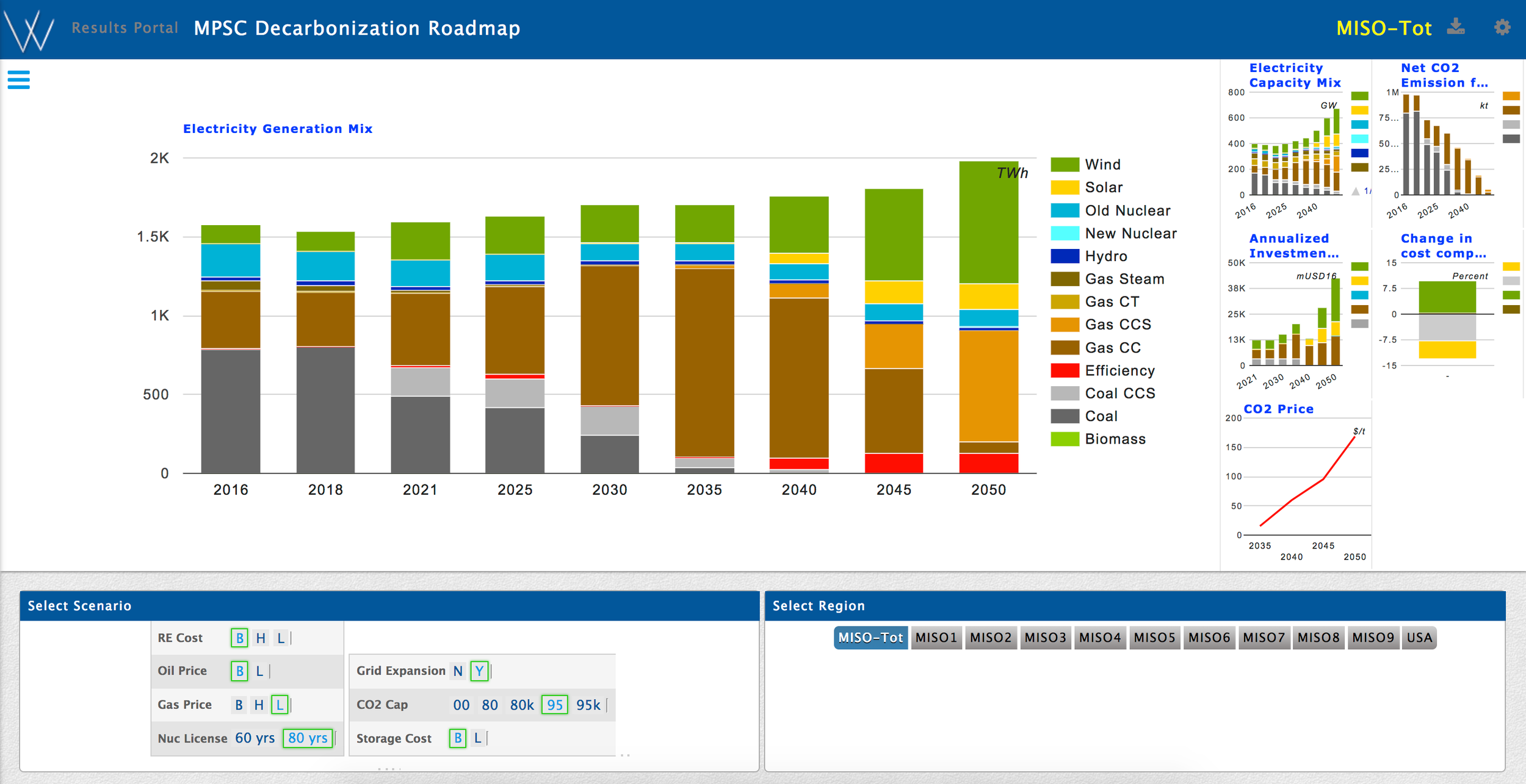Midcontinent Power Sector Collaborative
Electricity Decarbonization Roadmap
FACETS was used to create and analyze decarbonization scenarios for the Midcontinent Power Sector Collaborative (MPSC), which brings together a diverse set of stakeholders from across the Midcontinent Independent System Operator (MISO) region. The MPSC is developing a series of roadmaps exploring pathways to energy system decarbonization by midcentury.
This electricity sector roadmap analysis examined scenarios for 80 to 95 percent carbon emissions reduction in the US power sector, with a focus on the implications for the MISO region. Over 200 FACETS runs analyzed business-as-usual and carbon cap scenarios under uncertainties about natural gas and oil prices, technology costs, license periods for nuclear units, and the availability of inter-regional transmission expansion. Key findings include:
WITHOUT new policies, regional emissions span a wide range, but do not achieve substantial decarbonization
Without new action to promote decarbonization, the current trend away from coal towards natural gas and renewables continues, but it is insufficient to achieve substantial decarbonization by midcentury. Across business-as-usual scenarios, 2050 regional emissions cover a range from 5 to 40 percent below 2016 levels. Also without new carbon policies, existing nuclear units continue to face competitive pressure, and many units may retire before the end of their license periods.
A carbon cap accelerates the shift from coal to natural gas and renewables, and makes preserving existing nuclear units more economic. A mix of technologies is needed to achieve decarbonization in all scenarios. However, the mix varies a great deal by scenario, depending on the costs and availability of different technologies.
Policy costs are modest into the 2030s, with 2030 allowance prices remaining below $25/ton in even the most costly scenarios. Allowance prices rise as caps tighten in the 2040s, however, suggesting that continued innovation is important to keep costs down.
Natural gas prices have by far the greatest impact on technology and policy cost outcomes. When gas prices are low and emissions reduction requirements are modest, natural gas combined cycle (NGCC) units out-compete other resources. However, as the cap tightens towards mid-century, utilization of uncontrolled gas plunges and costs rise, as all this gas capacity must be either retrofitted with carbon capture and storage (CCS) or replaced with lower-emitting sources. When gas prices are higher, a broader mix of generation types are built throughout the modeling horizon, including more renewable capacity and, with very high gas prices, new nuclear.
Expanded renewable generation plays a role in all decarbonization pathways, but just how much is sensitive to future technology development. When technology cost and performance are frozen at today's levels and gas prices are low, wind and solar contribute only modestly to decarbonization goals, and the midcentury mix is dominated by gas with CCS. Continued aggressive renewable cost declines, on the other hand, lead to renewable penetrations that can reach up to nearly 70 percent of the region's mix. Lower storage costs can support increased renewable penetrations when the economics favor renewable development. You can read more about how renewables are modeled in FACETS here.
Explore full analysis results in the online portal
Other uncertainty dimensions have lesser impact on pathway outcomes. Allowing new interregional transmission results in a policy cost savings of up to 15 percent by 2050, because transmission allows access to high quality wind resources. In some scenarios, this can greatly increase electricity exports from MISO to the rest of the country.
The full set of pathway results with all uncertainty dimensions can be explored in the results portal. Read the MPSC Electricity Roadmap report here. Read more about FACETS' technology representation and data sources here.
Future roadmaps will examine electrification and deep energy efficiency options in the transportation and buildings sectors. Sign up on the right sidebar to receive updates about the roadmap analyses.

